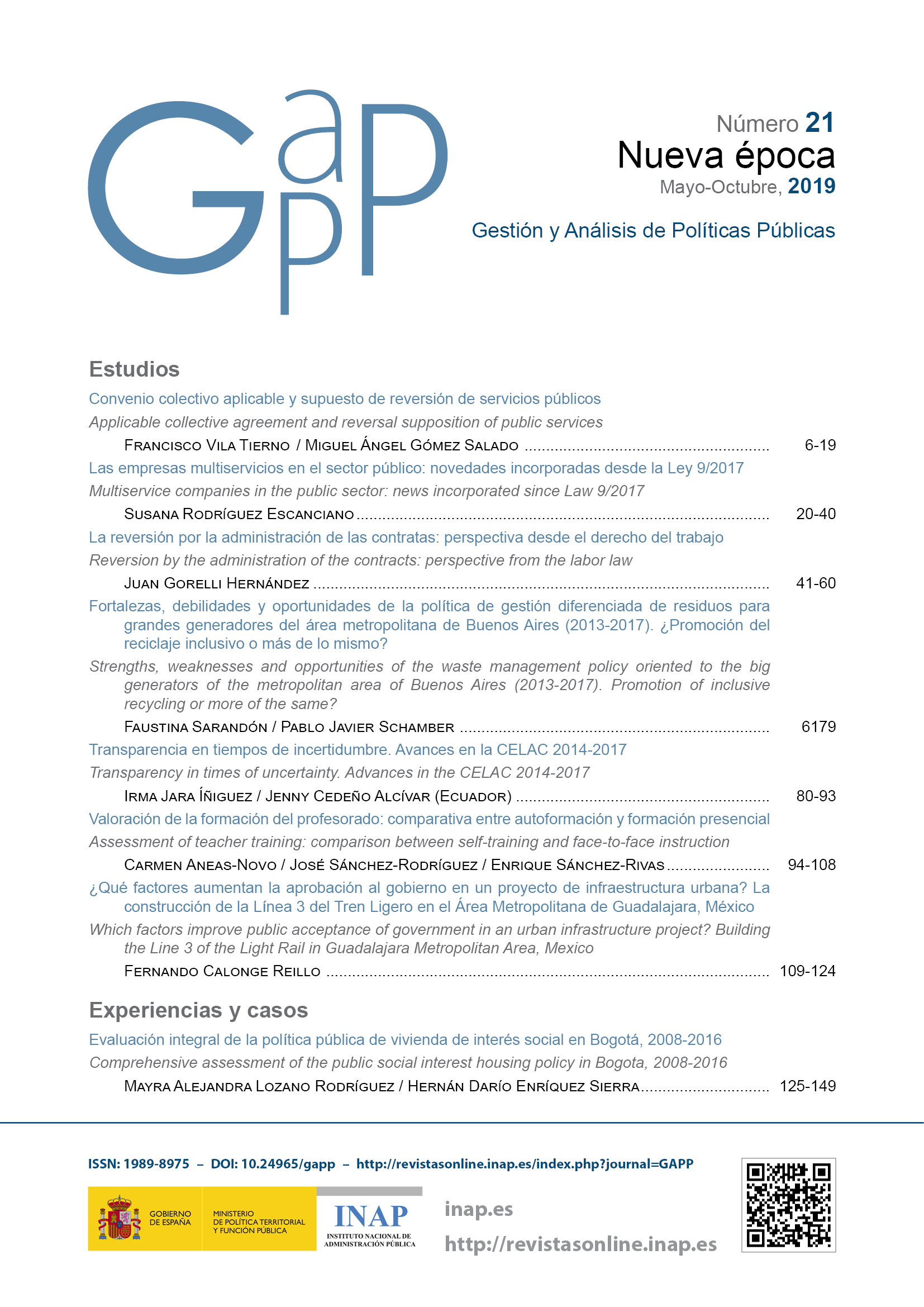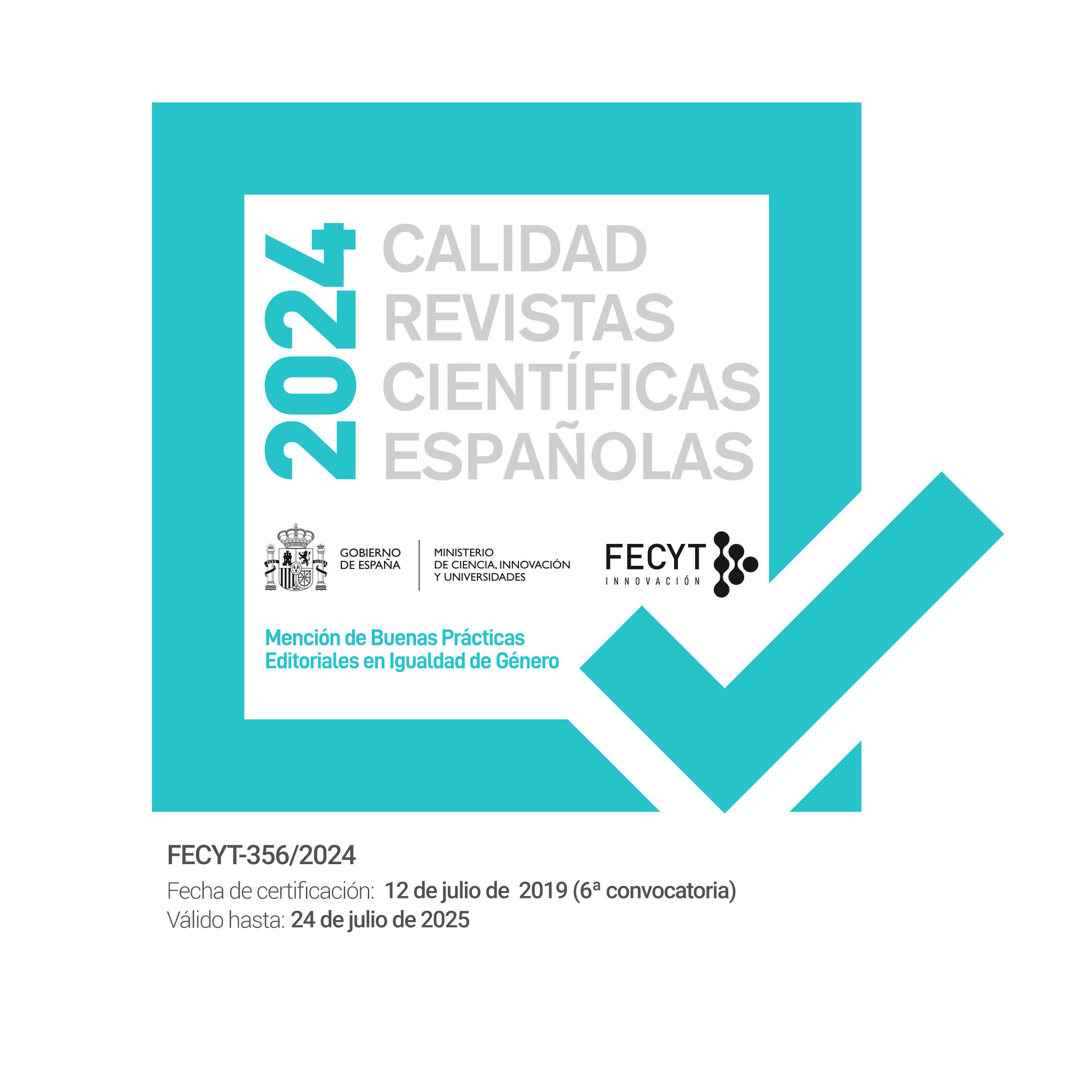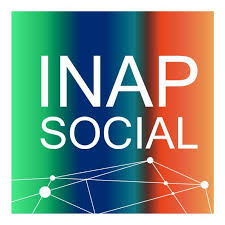¿Qué factores aumentan la aprobación al gobierno en un proyecto de infraestructura urbana? La construcción de la Línea 3 del Tren Ligero en el Área Metropolitana de Guadalajara, México
DOI:
https://doi.org/10.24965/gapp.v0i21.10537Palabras clave:
Megaproyectos, opinión ciudadana, políticas de transporte, transporte masivoResumen
El papel de los grandes proyectos de infraestructuras urbanas es cada vez más importante a escala global y en la región latinoamericana. Con la implementación de esquemas de gobernanza urbana, es fundamental conocer cómo la ciudadanía evalúa la actuación gubernamental en este tipo de inversiones. Este artículo se basa en los resultados de una encuesta aleatoria desarrollada en el Área Metropolitana de Guadalajara, México. Sus principales resultados subrayan cómo la mejora de los mecanismos participativos y la reducción de los impactos directos a los vecinos, son las dimensiones más decisivas que coadyuvan a la aprobación de la actuación gubernamental.
Descargas
Citas
ALLEN, J. y LLOYD JONES, T. (2010): “Neighborhood Asset Management: Life Cycles and Learning for Social Sustainability”, en MANZI, T. et al. (eds.): Social Sustainability in Urban Areas. Communities, Connectivity and the Urban Fabric, págs. 65-82. London: Earthscan.
ANAND, N. (2011): “Pressure: The Poli-Technics of Water Supply in Mumbay”, en Cultural Anthropology, vol. 26, núm. 4, págs. 542-564. DOI: https://doi.org/10.1111/j.1548-1360.2011.01111.x.
BAKKER, K. (2010): Privatizing water. Governance failure and the world’s urban water crisis. London: Cornell University Press.
BARKER, J. (2005): “Engineers and Political Dreams: Indonesia in the Satellite Age”, en Current Anthropology, vol. 46, núm. 5, págs. 703-727. DOI: https://doi.org/10.1086/432652.
BATTAGLIA, M., MELONI, E. y CAUTILLO, A. (2014): “Technical Assesments and Public Perception of Environmental Issues. The Case of the Municipality of Pisa”, en Local Environment, vol. 19, núm. 7, págs. 786-802. DOI: https://doi.org/10.1080/13549839.2013.792049.
BON, B. (2015): “A New Megaproject Model and a New Funding Model. Travelling Concepts and Local Adaptations around the Delhi Metro”, en Habitat International, vol. 45, págs. 223-230. DOI: https://doi.org/10.1016/j.habitatint.2014.06.008.
BRODZINSKY, S. (2014): “A Tale of Two Cities. Bogota”, en Americas Quaterly, Winter 2014, págs. 74-82.
BUNNELL, T. (2002): “Kampung Rules. Landscape and the Contested Government of Urban(e) Malayness”, en Urban Studies, vol. 39, núm. 9, págs. 1.685-1.701. DOI: https://doi.org/10.1080/00420980220151727.
DA SILVA, A. (2010): “Sao Paulo and the Challenges for Social Sustainability: The Case of an Urban Housing Policy”, en POLESE, M. y STREN, R. (eds.): The Social Sustainability of Cities: Diversity and the Management of Change, págs. 202-227. Toronto: University of Toronto Press.
DALAKOGLOU, D. (2010): “The Road: An Ethnography of the Albanian-Greek Cross Border Motorway”, en American Anthropologist, vol. 37, núm. 1, págs. 132-149. DOI: https://doi.org/10.1111/j.1548-1425.2010.01246.x.
DÁVILA, J. y BRAND, P. (2010): “La gobernanza del transporte público urbano. Indagaciones alrededor de los metrocables de Medellín”, en Revista Bitácora Urbano Territorial, vol. 21, núm. 2, págs. 85-96.
DIETZ, S. y ATKINSON, G. (2005): “Public Perceptions of Equity in Environmental Policy. Traffic Emissions Policy in an English Urban Area”, en Local Environment, vol. 10, núm. 4, págs. 445-459. DOI: https://doi.org/10.1080/13549830500160982.
DUPONT, V. D. N. (2011): “The Dream of Delhi as a Global City”, en International Journal of Urban and Regional Research, vol. 35, núm. 3, págs. 533-554. DOI: https://doi.org/10.1111/j.1468-2427.2010.01027.x.
EVANS, P. (2002): “Introduction. Looking for Agents of Urban Livability in a Globalized Political Economy”, en EVANS, P. (ed.): Livable Cities? Urban Struggles for Livelihood and Sustainability, págs. 1-30. Berkeley: University of California Press.
FLYVBJERG, B. (2005): “Machiavellian Megaprojects”, en Antipode, vol. 37, núm. 1, págs. 18-22. DOI: https://doi.org/10.1111/j.0066-4812.2005.00471.x.
FLYVBJERG, B. (2009): “Survival of the unfittest: why the worst infrastructure gets built - and what we can do about it”, en Oxford Review of Economic Policy, vol. 25, núm. 3, págs. 344-367. DOI: https://doi.org/10.2139/ssrn.2229768.
FLYVBJERG, B. (2014): “What You Should Know About Megaprojects and Why: An Overview”, en Project Management Journal, vol. 45, núm. 2, págs. 6-19. DOI: https://doi.org/10.1002/pmj.21409.
GRIECO, M. (2015): “Social Sustainability and Urban Mobility. Shifting to a Socially Responsible Pro-Poor Perspective”, en Social Responsibility Journal, vol. 11, núm. 1, págs. 82-97. DOI: https://doi.org/10.1108/srj-05-2014-0061.
GROVE, K. (2009): “Rethinking the Nature of Urban Environmental Politics: Security, Subjectivity and the Non-Human”, en Geoforum, núm. 40, págs. 207-216. DOI: https://doi.org/10.1016/j.geoforum.2008.09.005.
HUMPHREY, C. (2003): “Ideology in Infrastructure. Architecture and Soviet Imagination”, en Journal of the Royal Anthropological Institute, núm. 11, págs. 39-58. DOI: https://doi.org/10.1111/j.1467-9655.2005.00225.x.
HARVEY, P. (2012): “The Topological Quality of Infrastructural Relation. An Ethnographic Approach”, en Theory, Culture and Society, vol. 29, núm. 4-5, págs. 76-92. DOI: https://doi.org/10.1177/0263276412448827.
HESS, D. J. (2009): Localist Movements in a Global Economy. Sustainability, Justice and Urban Development in the United States. London: The MIT Press.
JANSE, G. y KONIJNENDIJK, C. C. (2007): “Communication Between Science, Policy and Citizens in Public Participation in Urban Forestry. Experiences from Neighborwoods Project”, en Urban Forestry and Urban Greening, núm. 6, págs. 23-40. DOI: https://doi.org/10.1016/j.ufug.2006.09.005.
JORDHUS LIER, D. (2015): “Community resistance against megaprojects: The case of the N2 Gateway project in Joe Slovo informal settlement, Cape Town”, en Habitat International, vol. 45, págs. 169-176. DOI: https://doi.org/10.1016/j.habitatint.2014.02.006.
KAIKA, M. y SWYNGEDOUW, E. (2000): “Fetishizing the Modern City: The Phantasmagoria or Urban Technological Networks”, en International Journal of Urban and Regional Research, vol. 24, núm. 1, págs. 120-138. DOI: https://doi.org/10.1111/1468-2427.00239.
KASH, G. e HIDALGO, D. (2014): “The promise and challenges of integrating public transportation in Bogotá, Colombia”, en Public Transport, vol. 6, págs. 107-135. DOI: https://doi.org/10.1007/s12469-013-0083-7.
KECK, M. E. (2002): “Water, Water, Everywhere, Nor Any Drop to Drink. Land Use and Water Policy in Sao Paulo, Brazil”, en EVANS, P. (ed.): Livable Cities? Urban Struggles for Livelihood and Sustainability, págs. 162-194. Berkeley: University of California Press.
KHAN, N. (2006): “Flaws in the Flow. Roads and their Modernity in Pakistan”, en Social Text, vol. 24, núm. 4, págs. 87-113. DOI: https://doi.org/10.1215/01642472-2006-012.
LARKIN, B. (2013): “The Politics and Poetics of Infrastructure”, en Annual Review of Anthropology, vol. 42, págs. 327-343. DOI: https://doi.org/10.1146/annurev-anthro-092412-155522.
LARKING, B. (2008): Signal and Noise. Media, Infrastructure and Urban Culture in Nigeria. London: Duke University Press.
LEVINE, M. V. (2000): “A Third World City in the First World? Social Exclusion, Racial Inequality and Sustainable Development in Baltimore, Maryland”, en POLESE, M. y STREN, R. (eds.): The Social Sustainability of Cities. Diversity and the Management of Change, págs. 122-156. London: University of Toronto Press.
MCCRIGHT, A. y CLARK, T. N. (2006): “The political opportunity structure of the environmental movement in the U. S. communities”, en MCCRIGHT, A. y CLARK, T. N. (eds.): Community and Ecology: Dynamics of Place, Sustainability, and Politics, págs. 199-240. New York: Elsevier.
MANZI, T. (2010): “Creating Sustainable Neighborhoods? The Development and Management of Mixed Income Communities”, en MANZI, T. et al. (eds.): Social Sustainability in Urban Areas. Communities, Connectivity and the Urban Fabric, págs. 35-48. London: Earthscan.
MANZI, T., LUCAS, K., LLOYD JONES, T. y ALLEN, J. (2010): “Understanding Social Sustainability: Key Concepts and Developments in Theory and Practice”, en MANZI, T. et al. (eds.): Social Sustainability in Urban Areas. Communities, Connectivity and the Urban Fabric, págs. 1-34. London: Earthscan.
MARINCIONI, F. y APPIOTI, F. (2009): “The Lyon-Turin High Speed Rail. The Public Debate and Perception of Environmental Risk in Susa Valley, Italy”, en Environmental Management, vol. 43, núm. 5, págs. 863-875. DOI: https://doi.org/10.1007/s00267-009-9271-2.
MATTELART, A. y MATTELART, M. (1997): Historia de las Teorías de la Comunicación. Barcelona: Paidós.
MORENO CARRANCO, M. (2013): “Global Mexico under Construction. The Santa Fe Megaproject in Mexico City”, en IRAZABAL, C. (ed.): Transbordering Latin Americas. Liminal Places, Cultures and Powers, págs. 187-214. New York: Routledge.
NORTON, B. (2002): “Ecology and Opportunity: Intergenerational Equity and Sustainable Options”, en DOBSON, A. (ed.): Fairness and Futurity. Essays on Environmental Sustainability and Social Justice, págs. 118-150. Oxford: Oxford University Press.
NOVY, J. y PETERS, D. (2013): “Railways Megaprojects as Catalysts for the Remaking of Post-Industrial Cities? The Case of Stuttgart 21 in Germany”, en DEL CERRO SANTAMARÍA, G. (ed.): Urban Megaprojects. A Worldwide Review, págs. 237-262. Bingley: Emerald.
PAGET-SEEKINS, L. (2015): “Bus Rapid Transit as a Neoliberal Contradiction”, en Journal of Transport Geography, vol. 48, págs. 115-120. DOI: https://doi.org/10.1016/j.jtrangeo.2015.08.015.
PÉREZ NEGRETE, M. (2016): “Ciudad de México: el camino recorrido en la conformación de una ciudad global”, en Revista Mexicana de Ciencias Políticas y Sociales, núm. 226, págs. 331-352. DOI: https://doi.org/10.1016/s0185-1918(16)30013-7.
RUMING, K. J. (2014): “Urban Consolidation, Strategic Planning and Community Opposition in Sydney, Australia. Unpacking Policy Knowledge and Public Perceptions”, en Land Use Policy, vol. 39, págs. 254-265. DOI: https://doi.org/10.1016/j.landusepol.2014.02.010.
SACK, D. (2011): “Governance failures in integrated transport policy. On mismatch of «co-opetition» in multi level analysis”, en German Policy Studies, vol. 7, núm. 2, págs. 43-70.
SCHNEIER-MADANES, G. (2005): “Conflicts and the Rise of Users’ Participation in Buenos Aires Water Supply Concession, 1993-2003”, en COUTARD, O., HANLEY, R. E. y ZIMMERMAN, R. (eds.): Sustaining Urban Networks. The Social Diffusion of Large Technical Systems, págs. 151-171. London: Routledge.
SCHOT, J. (2003): “The Contested Rise of a Modernist Technology Politics”, en MISA, T. J., BREY, P. y FEENBERG, A. (eds.): Modernity and Technology, págs. 257-302. London: The MIT Press.
SIEMIATYCKI, M. (2006): “Message in a Metro. Building Urban Rail Infrastructure and Image in Delhi, India”, en International Journal of Urban and Regional Research, vol. 30, núm. 2, págs. 277-292. DOI: https://doi.org/10.1111/j.1468-2427.2006.00664.x.
SIEMIATYCKI, M. (2005): “Beyond Moving People: Excavating the Motivations for Investing in Urban Public Transit Infrastructure in Bilbao, Spain”, en European Planning Studies, vol. 13, núm. 1, págs. 23-44. DOI: https://doi.org/10.1080/0965431042000312398.
SMITH, A. (2010): “The Relations Between Major Events, the Urban Fabric and Social Sustainability”, en MANZI, T. et al. (eds.): Social Sustainability in Urban Areas. Communities, Connectivity and the Urban Fabric, págs. 199-220. London: Earthscan.
STREN, R. y POLESE, M. (2000): “Understanding the New Sociocultural Dynamics of Cities: Comparative Urban Policy in Global Context”, en POLESE, M. y STREN, R. (eds.): The Social Sustainability of Cities: Diversity and the Management of Change, págs. 3-38. Toronto: University of Toronto Press.
TURNER, J. (2012): “Urban Mass Transit, Gender Planning Protocols and Social Sustainability. The Case of Jakarta”, en Research in Transportation Economics, núm. 34, págs. 48-53. DOI: https://doi.org/10.1016/j.retrec.2011.12.003.
VALENTIN, V. y BOGUS, S. M. (2013): “Public Opinion as an Indicator of Social Sustainability of Construction Projects”, en International Conference on Sustainable Design, Engineering and Construction, año 2012, págs. 561-568.
VALENZUELA, A. (2013): “Dispositivos de la globalización: la construcción de grandes proyectos en la Ciudad de México”, en EURE, vol. 38, núm. 116, págs. 101-118. DOI: https://doi.org/10.4067/s0250-71612013000100004.












